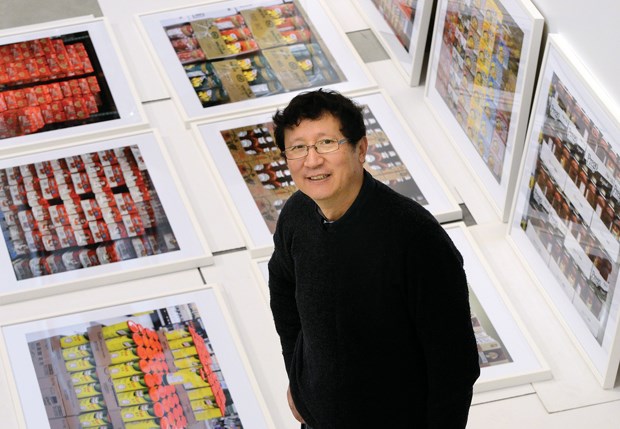Gu Xiong: a journey exposed, on display until Aug. 23 at the Gordon Smith Gallery of Canadian Art, 2121 Lonsdale Ave., North Vancouver. For more information, visit gordonsmithgallery.ca.
The old adage that no two snowflakes are alike could also apply to clay pigs, crushed Coke cans and rotting tomatoes as visitors to the Gu Xiong: a journey exposed exhibit at the Gordon Smith Gallery of Canadian Art will discover.
Inside the North Vancouver gallery, curator Astrid Heyerdahl stands over 10,000 palm-sized clay pigs that have been formed into a winding river that snakes down the centre of the gallery. Most of the small figures were hand-sculpted by North Shore elementary and high school students, Heyerdahl explains, pausing when a familiar swine catches her eye.
"Ooh, I made this one," she says excitedly, bending down to admire her handiwork.
Collectively, the thousands of clay figures make up A Pigs River, the central work in a journey exposed, which is on display until Aug. 23. The installation represents the more than 10,000 pig carcasses that were dumped into the Huangpu River in China in March 2013, and event that raised alarm over the safety of drinking water and food production.
"This is the trigger for the whole exhibition and the heart of the whole exhibition. Everything is contextualized, really, around this work," Heyerdahl says. She hopes the collaborative nature of the installation will help connect local youth to the exhibit.
"If you're a 10-year-old or a 12-year-old or a 17-year-old and you're coming into the gallery and you're searching for your pig, it has a different kind of meaning to you than seeing artwork that you had no relationship with."
Through new works and earlier works brought into a new context, a journey exposed explores themes of international connectivity, world food production and political activism, along with Xiong's personal experiences of struggle and success.
Born in Chongqing, China, Xiong received his BFA and MFA degrees from the Sichuan Fine Arts Institute and was an important figure in the avant-garde movement in China in 1980s. He moved to Canada after the Tiananmen Square massacre and was inspired to create his Coca-Cola series in the early 1990s while working as a busboy at UBC.
"He saw a student one day crush a can before throwing it out, and that to him was actually very inspirational," Heyerdahl explains. The mass produced object, in the process of being destroyed, had gained a new life. "As soon as you crush it, that's when it becomes unique."
On one wall of the Gordon Smith gallery is an impressive swath of 2,750 flattened North American and Chinese Coca-Cola cans. Much like his cans, Xiong's dreams of free artistic expression were crushed under Communist government censorship and, upon arriving in Canada, his dreams of making it as an artist in his new country were also crushed - at first.
During his busboy days, Xiong, who today works as a visual arts professor at UBC, pursued his creative passion on the side and created his Cafeteria series of silkscreen prints depicting plastic forks, food scraps, paper plates, wrappers and drink containers.
"He was sort of wading through the detritus of society," Heyerdahl says. "He was constantly surrounded by garbage, taking out garbage, observing practices of his new culture, his new society."
Also part of the exhibit is Waterscapes, a geographic painting that shrinks the gap between the east coast of China and the west coast of Canada, as well as Xiong's Mass-produced Food series of inkjet images that depict stacked case lots of Heinz ketchup, Prego pasta sauce, Kraft peanut butter and Warhol-esque Campbell's tomato soup cans.
Wandering into the back room of the gallery, the slightly acrid smell of fruit in the early stages of decay greets the nostrils. Perhaps the most conceptual work in the exhibit, Invisible in the Light features some 21,000 grape tomatoes pinned to the walls and hanging from the ceiling on invisible fishing line. A few days after installation, most of the tomatoes are still plump and red, but many are growing dark spots and a few are beginning to ooze red juice. When the show closes in August, Heyerdahl expects all the tomatoes will be reduced to black, shriveled remains.
Xiong's tomato installation was inspired by his research into the experiences of temporary migrant workers in B.C.'s Fraser Valley and Ontario's Niagara region.
"For him, it's really connected to the (Chinese) Cultural Revolution," Heyerdahl says, explaining that Xiong, while still in his youth, was sent to toil in the remote countryside for four years.
"There was a sense of hopelessness, total isolation."
Walking past the suspended tomatoes, Heyerdahl points out the delicate oval shadows cast on the gallery floor.
"It's just so beautiful and I love his work because of that. It's very conceptual, it's very contemporary, and yet still so beautiful, so esthetically pleasing, so touching to many individuals who may not necessarily be connected with contemporary art," she says. "His work can be so inspirational if you look at it closely."



